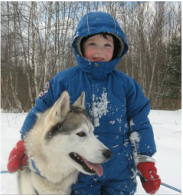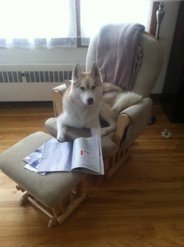The Siberian Husky - A Profile

Original Purpose: The Siberian was the primary mode of transportation for the Chukchi people of Siberia. They were "hardy dogs with speed and endurance ... most capable of carrying a light load at a moderate speed over great distances” while requiring little food. Also used "as companions for their children and hunters for their food. " They were first brought over to Alaska in 1908 used as working dogs and in races such as the All Alaska Sweepstakes. The Siberian became famous after the 1925 serum run to Nome when diphtheria antitoxin was transported 674 miles by dog sled. Although not as fast as the today's Alaskan Huskies, some dedicated Siberian breeders still run their Siberians in the 1,000 mile Iditarod and Yukon Quest aces.
General Characteristics: "The Siberian Husky is a medium-sized [35-60 lbs, 20-23 1/2 inches] working dog, light on his feet, free and graceful in action. His well-furred body, erect ears, and brush tail suggest his northern heritage. His body proportions and form reflect this basic balance of power, speed, endurance and general athletic abilities." "The males of the Siberian Husky breed are masculine but never coarse. The bitches are feminine but without weakness of structure. "All colours (solids and blended shades) and pure white are allowed and all markings. Eyes are shades of brown or blue, one of each or parti-coloured; all are equally acceptable."

"Temperament: “The characteristic temperament of the Siberian Husky is friendly and gentle, but also alert and energetic. As adults, the breed tends to be aloof and independent. His intelligence, natural workability and eager disposition make him an agreeable companion and willing worker, especially as a sled dog. He does not display the possessive qualities of a guard dog.”
They are normally good with children and will tolerate some unintended mistreatment from a child. This said, an adult should NEVER leave a young child unsupervised with any dog. They also normally get along with other dogs, although they can play too rough for some, particularly small dogs. The breed often does best in a multi dog family where they have a playmate to wear off some of their energy and to keep them company when their owners are not at home
They are normally good with children and will tolerate some unintended mistreatment from a child. This said, an adult should NEVER leave a young child unsupervised with any dog. They also normally get along with other dogs, although they can play too rough for some, particularly small dogs. The breed often does best in a multi dog family where they have a playmate to wear off some of their energy and to keep them company when their owners are not at home
Grooming, Exercise and General Care: When they are not shedding the Siberian requires little grooming care. However, they have a thick double coat that they shed once or twice a year that comes out in clumps of fur. Frequent grooming is required to keep things under control during this time. The nice thing about their double coat is that there is not a lot of smell, even when they get wet. Mud, dirt seems to just fall away from the coat as it drys.
Siberians, particularly young ones, require a fair amount of exercise. If you are a fairly active person who likes jogging, biking, ski-joring, dog sledding, agility or other activities then the breed could be a good match for you. However, if you just want the Siberian to be a "show piece" on your couch with little exercise then you will quickly find out how

Desire to Run and Pull: Considering the breed's history, it should not be a surprise that they love to run and pull. With patience theycan be trained not to pull, however, some are escape artists that are just not safe off lead. If you have to have a dog that is good off lead, the Siberian is not for you.
High Prey Drive: Many Siberians have a very high prey drive which can be a serious problem with them around small animals including chickens, rabbits, and cats. Although some are good with cats, don't assume that raising the Siberian from a puppy around a cat will ensure that it will be good with the cat as an adult.
High Prey Drive: Many Siberians have a very high prey drive which can be a serious problem with them around small animals including chickens, rabbits, and cats. Although some are good with cats, don't assume that raising the Siberian from a puppy around a cat will ensure that it will be good with the cat as an adult.

Time, Patience, Humour: However, if the owner has the time, patience, determination, and a good sense of humour can help too; the same Siberian traits that can be a real challenge for the novice owner can also be some of the breed's greatest assets enabling them to do many dog related activities and be a wonderful companions.

Research: Too many people get a Siberian just because they love their looks. Siberians are very intelligent and independent thinkers. They DO their research and are very good at training their humans. Make sure you also do your research before buying so you are prepared for the reality of living with a Siberian.
Also do your research on the breeder you are considering getting your dog from. A few questions to ask:
- Will my puppy be registered with the Canadian Kennel Club (your insurance of a purebred dog)?
- Are health checks being done and does the puppy come with a written health guarantee?
- Can you visit and meet at least the mother of the pups?
- Will the breeder be there to help AFTER sale?
Also do your research on the breeder you are considering getting your dog from. A few questions to ask:
- Will my puppy be registered with the Canadian Kennel Club (your insurance of a purebred dog)?
- Are health checks being done and does the puppy come with a written health guarantee?
- Can you visit and meet at least the mother of the pups?
- Will the breeder be there to help AFTER sale?
Lifelong Commitment and Responsible Ownership: Finally, the Siberian Husky has a normal life span of 10 to 14+ years. Responsible breeders make a lifelong commitment to any puppy they produce and will take them back if needed. However, responsible owners share in that commitment. They know that moving, a baby coming, time commitment, etc. are all things that should be considered prior to obtaining a dog! If they are having problems with their puppy / dog they contact their breeder early on and get help. If the dog does need to be rehomed, the owner does not shirk their responsibility by dumping the dog off at a shelter or rescue. Instead, the breeder is contacted and then the breeder and owner work together to find a suitable new home for the dog. If you are not prepared to be a responsible owner, PLEASE DO NOT get a Siberian in the first place!




